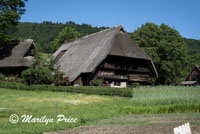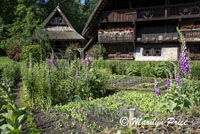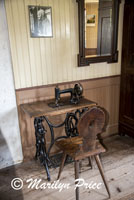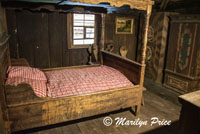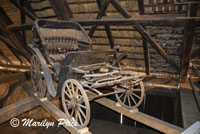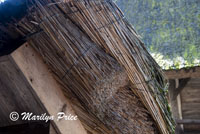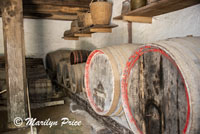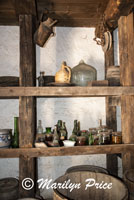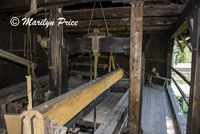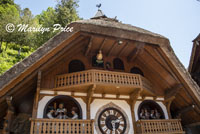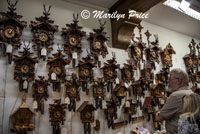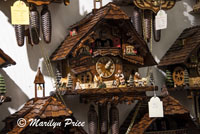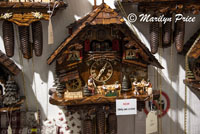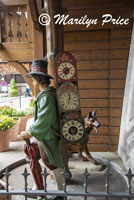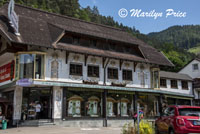May 31
June 1
June 2
June 3
June 4
June 5
June 6
June 7
June 8
June 9
June 10
June 11
June 12
Friday, June 7
I had a very restless night for some unknown reason. We got up early for breakfast and the bus ride to the Black Forest. It took 1.5 hours to get there.
Our first stop was the Open Air Museum. It was very interesting. We were there until about noon and I could have wandered around there a little longer.
The Open Air Museum gives its visitors a sense of what it was like to live on a Black Forest farm back in the day, and included buildings that had been moved to this location especially for this purpose.
The photo on the left shows a typical Black Forest farmhouse. The design is still in use today. In fact, the owner of this house lived in it until a few years back.
The photo on the right shows the front of this farmhouse through the kitchen garden. A kitchen garden supplied some of the fresh vegetable and herbs used on the farm. This garden also included foxglove, so some of the plants had medicinal uses, also.
The ground floor of some of the farmhouses was used for storage, much as a basement is in US farmhouses. That is, if the ground was steep enough. The next floor (or the ground floor for a house on a hill as gentle as this one) contained the public rooms in the front half of the house. These included the kitchen, family parlor, and guest parlor. The back half of this level was usually turned into stables and stalls for the farm animals.
The next floor, up a narrow flight of stairs, contained sleeping quarters for everyone on the farm, including family and farmhands. The next floor up was usually accessed by doors on the opposite end of the house - the uphill side - and allowed wagons to pull directly into the large loft area, which stored hay and other harvest items. It also served as a workshop and a place to store wagons in the winter or sleds in the summer.
The photo on the left shows the blackened ceiling of the kitchen, which wasn't vented. The center photo shows an old sewing machine in a place of honor in the formal parlor. Above the sewing machine is a photo of the last owner of this house. The photo on the right shows one of the smaller bedrooms of the farmhouse.
The photo on the left above shows an old carriage stored in the attic portion of the farmhouse. This one is on display, but it wasn't unusual to store a carriage in this area. Back in the day, however, it would probably be stored in the middle of the floor, not suspended along the rafters. The center photo shows a detail of the thatched roof. The reeds are bundled before attaching to the roof and are installed quite thickly. The photo on the right shows a "cat door" into the stable area allowing a cat to enter and leave as it desires.
The photo on the left shows a storehouse connected to this main farmhouse. This was used for storing seed for next year's crops and important papers and anything else that needed more protection. The man on his knees in front of it is one of the people that work here - he was pulling weeds out of the walkway.
The photo on the right shows a detail of the thatching for the storehouse. Part of the roof is done in a decorative fashion. Later, I realized that the main house had this arrangement also, but it was harder to see as it was in the shade at the time.
The formal part of this tour ended with the main farmhouse. We then spent the next hour wandering around looking at some of the other buildings on the site. They had moved several of the old buildings onto this one site for instructional purposes. It reminded me of Cades Cove in the Smokies...
The photo on the left above shows some barrels in the storage area of a second, smaller farmhouse. It's storage area was under the main house instead of a separate building. The center photo shows some old bottles also stored in this same area. The photo on the right shows a water powered sawmill. The rotation of the waterwheel would be translated into a vertical up and down sawing motion using a series of cogs. The blade here is the greenish looking vertical bar about 2/3 of the way down the log.
The bus then drove to Wolfach for lunch. It was a yummy lunch (mine was very dairy free) with chicken, potatoes, salad, peas, dessert. It was a fixed menu, so they made a couple of modifications for me, like boiled potatoes instead of the potato noodle like thing everyone else had and my chicken wasn't breaded. My dessert was just berries, no ice cream. Things like that.
The cook played piano for us after we finished.
Then it was back on the buses for the cuckoo clock store in Homberg. The owners have been woodcarvers for generations and clock makers for about as long. There were too many pretties!!!
Outside of the cuckoo clock store was the world's largest cuckoo clock. The photo on the left shows the top half of the clock. There were too many other people between me and it to show the bottom half.
The photo on the right shows a closer view of the panel on the left side of the clock. When the clock struck the hour (or someone fed enough money into the coin operated slot nearby), just about everything would go into action. The drinkers in this photo would lift their beer steins and the woman with them would brandish her rolling pin.
On the right side, the four gentlemen would "sing". The bird on the top level would cuckoo the hour. The man below her would "walk" across the balcony to be replace by another figure. And there was more going on on the lowest level. I never did get a good shot of that part...
These three photos show some of the cuckoo clocks for sale in the store. And I didn't see the "No Photos" sign until after I got home! The store also had a short wordcarving demonstration, fantastic grandfather clocks, and lots of souvenirs. Oh, and we were offered slices of Black Forest cake while here. I couldn't sample it and Carl was still full from lunch.
The photo on the left shows another detail from the world's largest cuckoo clock. This clock peddler and his dog would rotate around each other on the hour. The center photo shows the front of the clock store. There was merchandise on both floors! The photo on the right shows some of the rest of Homberg with the stream that runs through it. Our bus was parked next to this stream.
Then came the 1.5 hour bus ride back through the forest to the ship, which left dock almost immediately.
Our cruise director confused me with the disembarkation lists that he posted. He had us on two different lists.... With different times, instructions, and color of luggage tags.... He's apologized and we have it straightened out...
We attended Happy Hour in the Lounge as we went through another lock. Then the Captain's Cocktail Hour (with more alcohol). Then downstairs for the last dinner on board. Lots of conversation and we watched quite a few fond farewells.
Oh, one interesting thing. Unlike the big ocean going cruise ships, luggage is not put out for pickup until tomorrow morning, so last minute things can go into the big suitcases and not just the carry on sized ones.
Now it's time for bed. Tomorrow will start early.

